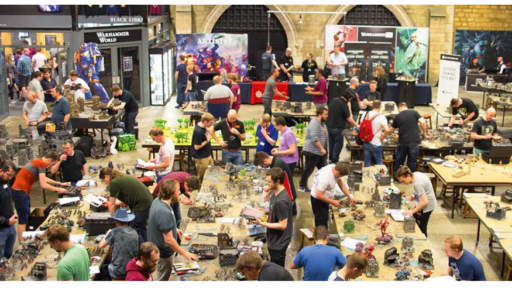
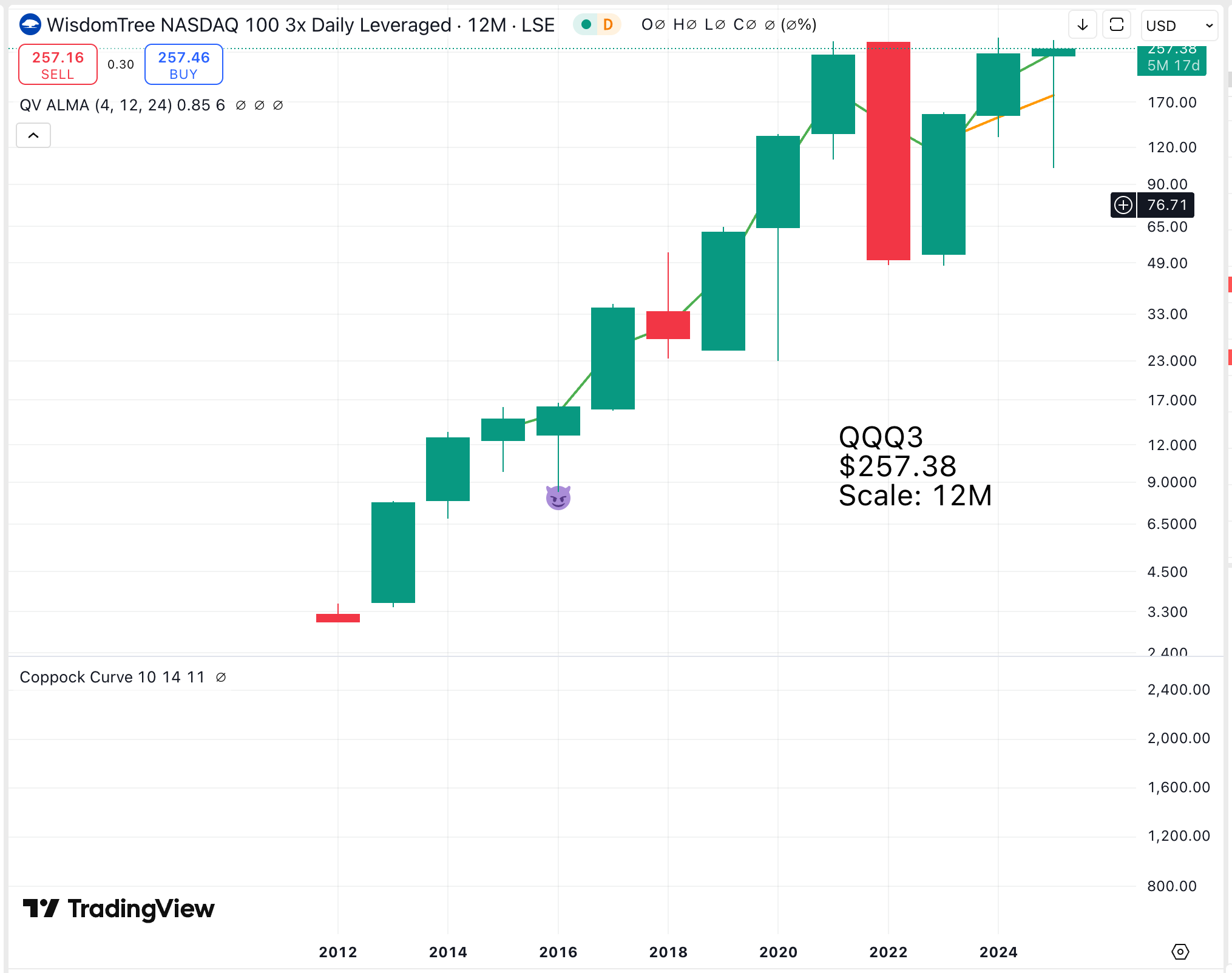
No lift-off yet from QQQ3, but the chart looks super-promising. So much so that I think I will believe we have lift-off when we do have a breakout on this chart.
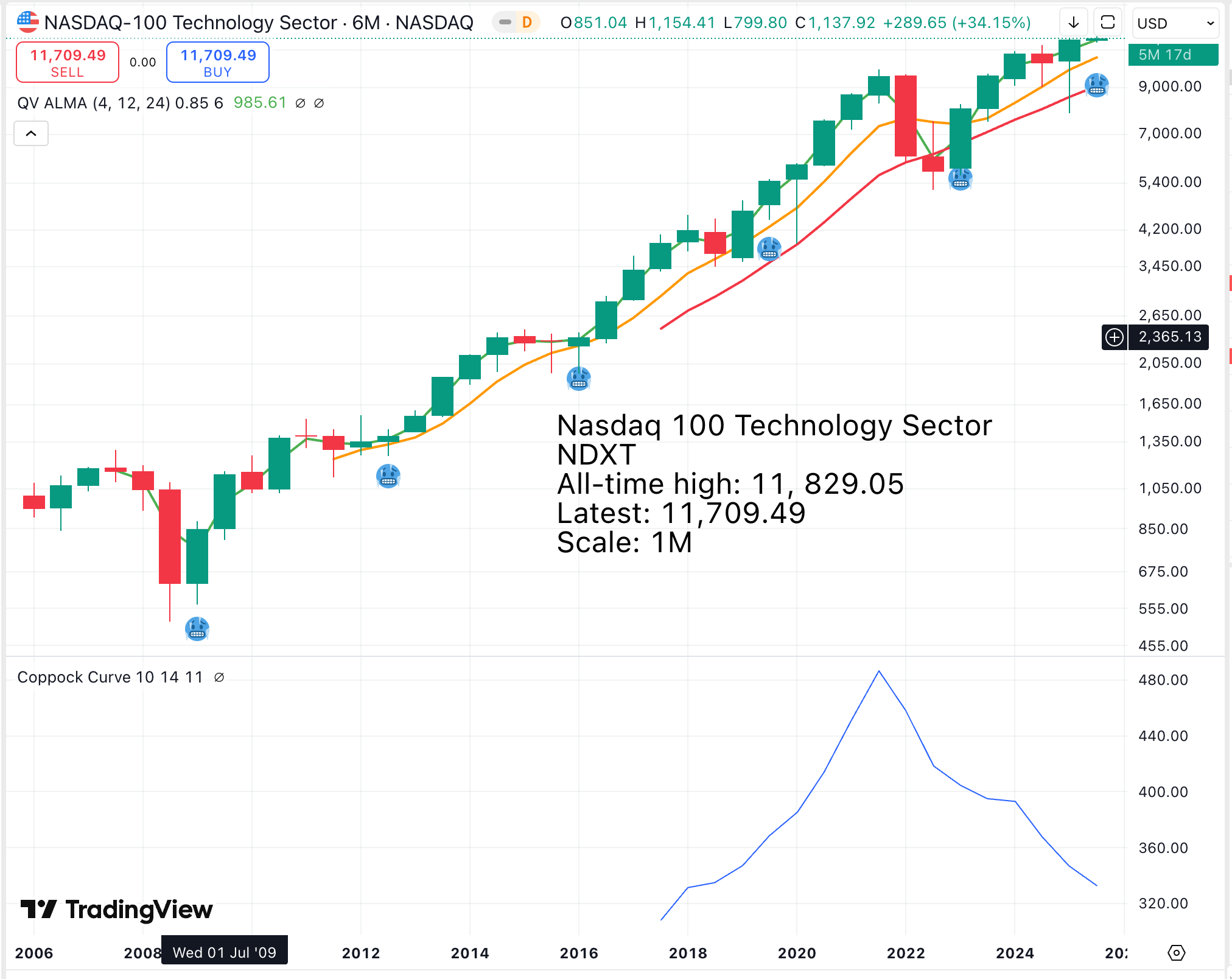
This chart of the Nasdaq 100 Technology index is stronger. It is also intriguing. It is long-term, based on six-month candlesticks. Coppock moves with long, slow sweeps, rising through a sustained bull phase and falling while the index bounced up and down. After rising for five years, the Coppock Curve has been falling for four years, so a turning point may not be too far in the future. A rising Coppock Curve would be a supportive background for investors.
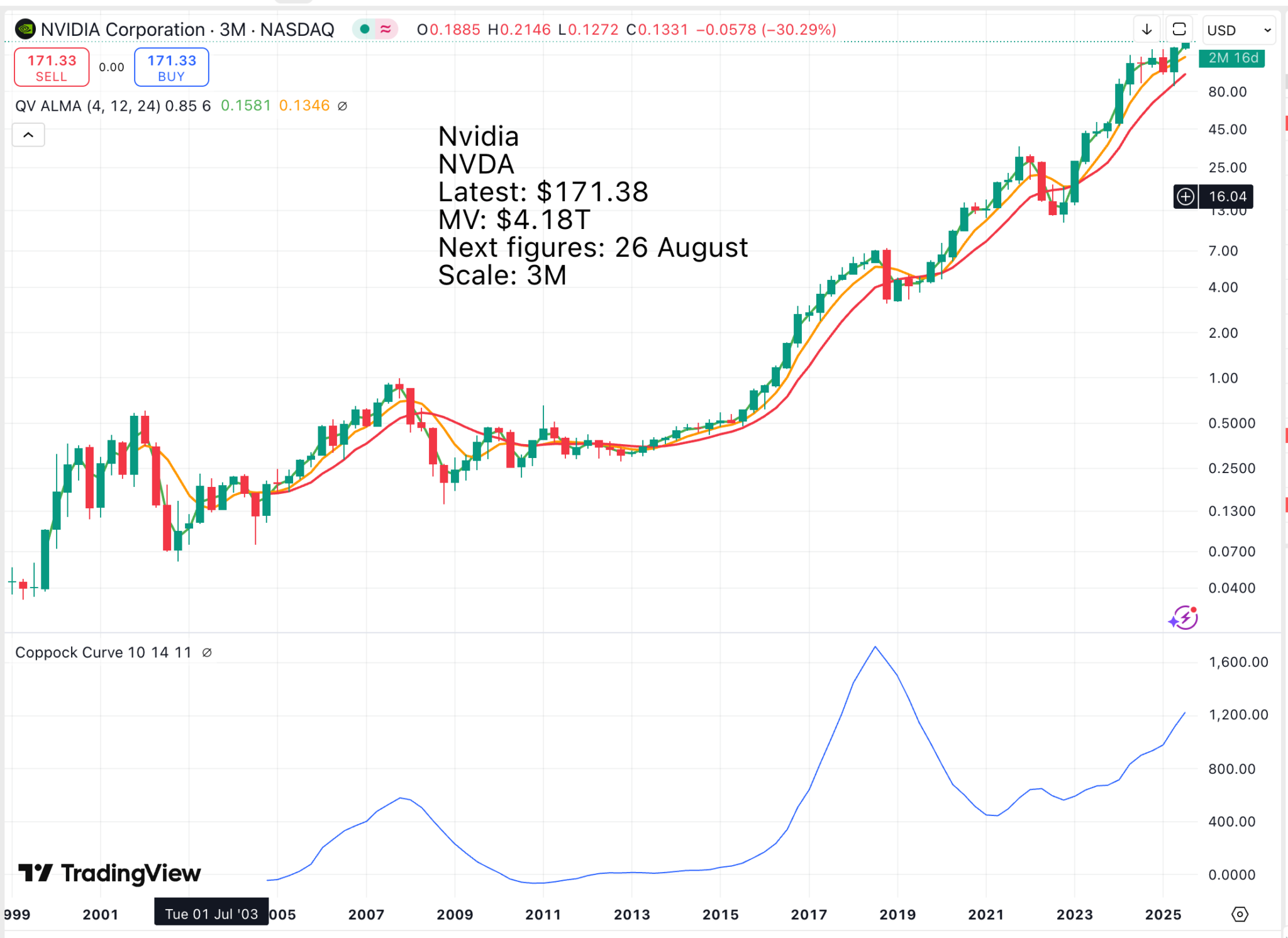
This is a strong chart with the moving averages looking positive, a chart breakout from a sideways pattern and a rising Coppock Curve. At first sight, the declining Coppock seems to have been a false signal, but more informative is to look at what happens when Coppock is climbing.
Those periods captured the bulk of the rise in share price, and the falling Curve kept you out when the shares were at risk. The current message is buy and/ or hold. As discussed in many previous alerts, the fundamentals remain amazing, and it seems that Nvidia will again have access to the important Chinese market.
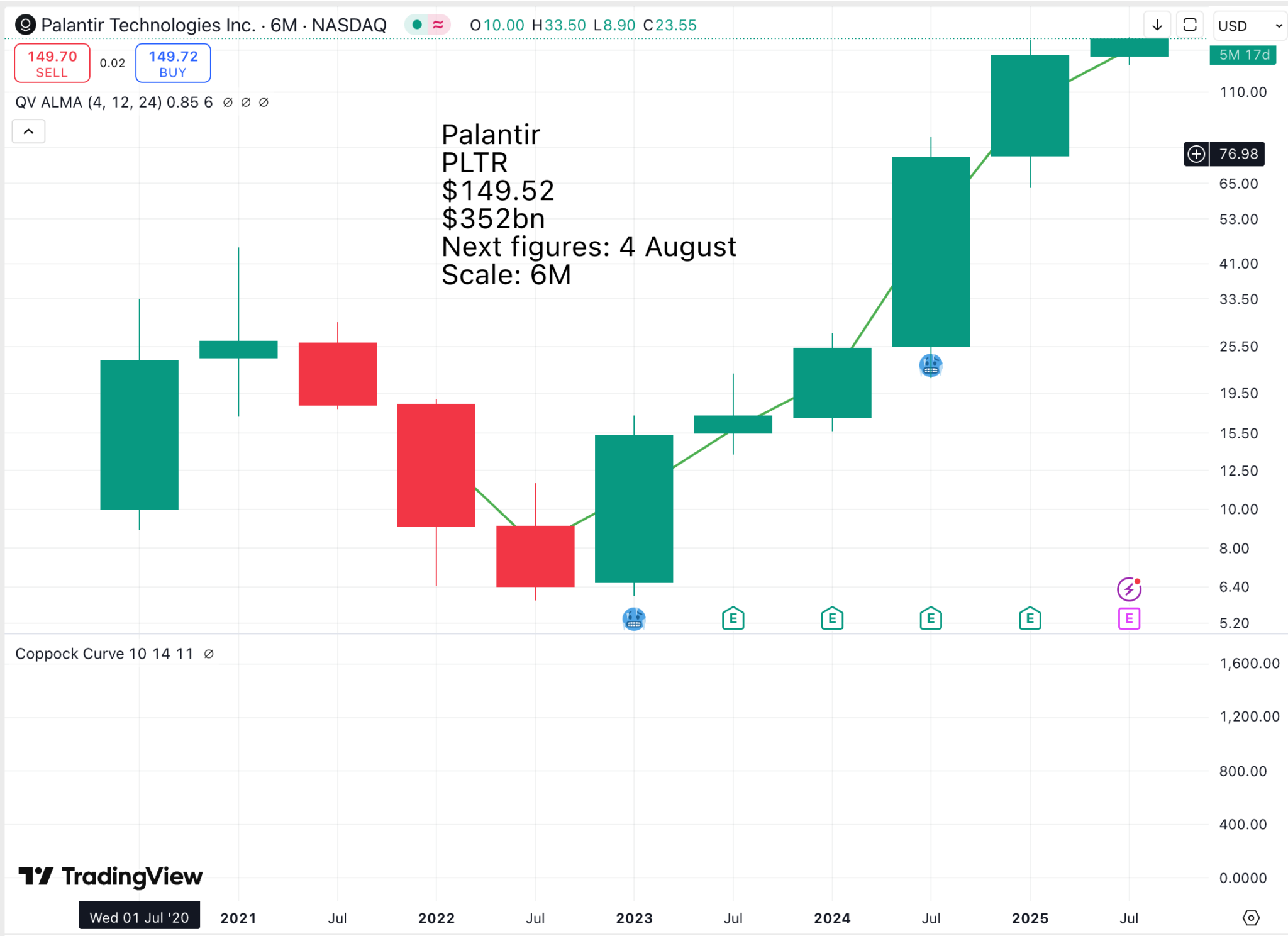
I see Nvidia v Palantir partly as a contest. The share prices are not wildly different, and presently, Nvidia is pulling ahead. It is also setting new levels for the biggest company by market value in the world. The latest figure is $4.18 trillion, a staggering figure. Nvidia has some 36,000 employees. There are so many noughts it is hard to be certain, but I think this values each employee at $114m.
Here is some history.
Founded in 1993 — famously, over a meal at Denny’s — Nvidia designs a special kind of programmable computer chip.
For decades, Intel and Advanced Micro Devices had dominated the U.S. chip sector.
But those companies specialized in producing CPUs — central processing units, which serve as the foundation for basic computing and software processes.
Nvidia, meanwhile, specialized in graphics processing units (GPUs). As their name suggests, GPUs are better able to render images, which meant that they were first associated with video and computer games.
But it turns out GPUs are also able to perform calculations concurrently in a way that regular CPUs cannot — making them more energy efficient and better able to handle sophisticated computing demands.
Over time, the other big chip makers began manufacturing their own GPUs to compete — but Nvidia, having enjoyed a first-mover advantage in the space, was where companies began to turn to for GPU needs.
It combined its chips with a suite of accompanying software that programmers simply preferred. Plus, its supply chain allowed it to produce GPUs in larger volumes, faster, and more reliably, than its rivals.
For instance, auto companies began turning to Nvidia chips for use in driver-assistance software that must process image information from sensors.
Nvidia hardware is now found in all Tesla vehicles.
Still, until 2020, Intel was a larger company by market capitalization than Nvidia.
Pandemic surge turns into AI revolution
During the pandemic, the shift to remote work and subsequent demand for data centers that could enable cloud-based computing — plus even more interest in video games while everyone was stuck indoors — accelerated Nvidia’s revenues even further.
Then Silicon Valley, led by OpenAI, began to realize the potential of artificial intelligence to transform how all companies do business.
The Nvidia ecosystem, from its software to its sourcing of materials, allowed it to position itself as the go-to source for companies that needed massive computing power to handle their AI needs.
Nvidia’s fortunes have since gone stratospheric: Today, it is worth nearly $3 trillion according to its current stock price — nearly as much as Apple.
Nvidia’s specialization means it is able to charge a premium for its products. In fact, its chips, which are manufactured in Taiwan, are so unique that companies looking to build AI capabilities are complaining that there is a shortage of them.
“The health of their core data center business is genuinely stunning,” Goldman Sachs’ Tony Pasquariello wrote in a note to clients Friday.
Because it is now so much more valuable, Nvidia’s financial results carry greater weight for major stock indices, acording to Agati, who is chief investment officer and managing executive for investments at PNC.
In other words as Nvidia goes, so goes the stock market.
“[Nvidia] has become critical to the market’s path forward,” Agati said in an email to NBC News, adding: “In the saying ‘data is the new oil,’ Nvidia continues to prove it is in a league of its own.”
NBC News, 24 February 2024
Nvidia doesn’t make anything, so what do those 36,000 employees do all day? I suppose they do a great deal of thinking. Nvidia is the greatest collection of brainiacs on the planet, steam rising from the heat generated by all those cogitations. They almost literally are the sharp end of the technological revolution. The burden of human progress rests on their T-shirted shoulders. It must be unimaginably exciting to work for Nvidia, like working on Enigma, alongside Alan Turing, during the Second World War.
Palantir is similar, helping militaries, governments and enterprises apply the incredible technology that Nvidia is creating. Palantir is valued at $350bn and has around 4,900 employees. This values each employee at $71m. The last time I did this calculation for Nvidia, each employee was valued at $70m. Like Nvidia, Palantir has no factories and doesn’t make anything. It is pure brain power which it applies to solving problems for its customers, bringing violence and death to America’s enemies, and making governments and enterprises dramatically more efficient.
The results it achieves are so staggering that customers who visit its boot camps sign up immediately, increase their spending dramatically every year and are happy to leave handsome profits on the table for Palantir.
Like many Millennials, The Guardian and its readers are in hand-wringing mode about Palantir and its bat-shit crazy CEO, Alex Karp. They think it is our moral duty not to fight wars and, if we must, to lose gracefully. Thank God, the big beasts of US technology no longer accept that supine approach. If we don’t stand tall, our enemies will walk all over us. Talk about having to state the bleeding obvious, but it seems it needs saying.
In 1935, a man called George Lansbury was Leader of the Parliamentary Labour Party. He made a moving speech at the Labour Party Conference in favour of pacifism. A man called Ernest Bevin, then the leader of the Trades Union Congress, followed him on the podium. In one of the most brutal speeches in Labour party history, he tore Lansbury to shreds. The latter was literally in tears and disappeared without a trace from subsequent Labour politics. This is a man’s world, and if you want to make progress and protect your nearest and dearest and the values you hold dear, you have to be a man. Roll over and beg doesn’t cut it.
The way I think about it is to imagine a John Wayne movie without John Wayne. When the bad guys ride into town, no big guy is waiting for them with a Colt 45 in his holster, a Winchester rifle in his hand and a steely glare in his eyes, just terrified townspeople. If America is not ready to stand and fight, the West would be like that town without John Wayne. It doesn’t bear thinking about.
Share Recommendations
Nvidia. NVDA
Palantir PLTR
Here is my man, Dan Ives, from Wedbush Securities, on Palantir. Sock it to them, Dan.
The AI revolution is being led by Nvidia and Microsoft, but Palantir, they’re going to be one of the core players. I’m seeing it as a trillion dollar company next two to three years, and look, the haters will hate.
But it’s just the beginning of the use cases playing out on enterprise, on government. That’s being led by Karp, and that’s why, you know, there’s only one Messi of AI and it’s PLTR.
What do you say to the skeptics, Dan, the bears, who will say, listen, and they’ve been on this show, and I’ve asked them, they’ll say, listen, I, I like the tech, they’ll tell me. I, I like the fundamentals. I don’t like the valuation. It’s an irrational valuation, is how they’ll put it, and say at these levels, the risk reward does not look attractive. What’s your response?
The bears are in hibernation mode and in their spreadsheets, they can’t see AI. And if you focus just on valuation, you missed every transformational growth stock in the last 20 years. And Palantir, they hated at $15, despised it at $50, yelling at $100. It’s going to continue. Again, it’s like right now, this is being what I view as one of the best AI plays in the world.
I know you tell your clients, say this one on the path, you argue to become the next Oracle.
Trillion dollar. It’s the next Oracle, the trillion dollar path. They’re in a left lane in a Ferrari going 100 miles an hour. A lot of the competition’s in a minivan going 45 miles an hour, right lane.
Yahoo Finance, Josh Lipton talking to Dan Ives, 14 July 2025
Way to go, Dan!



